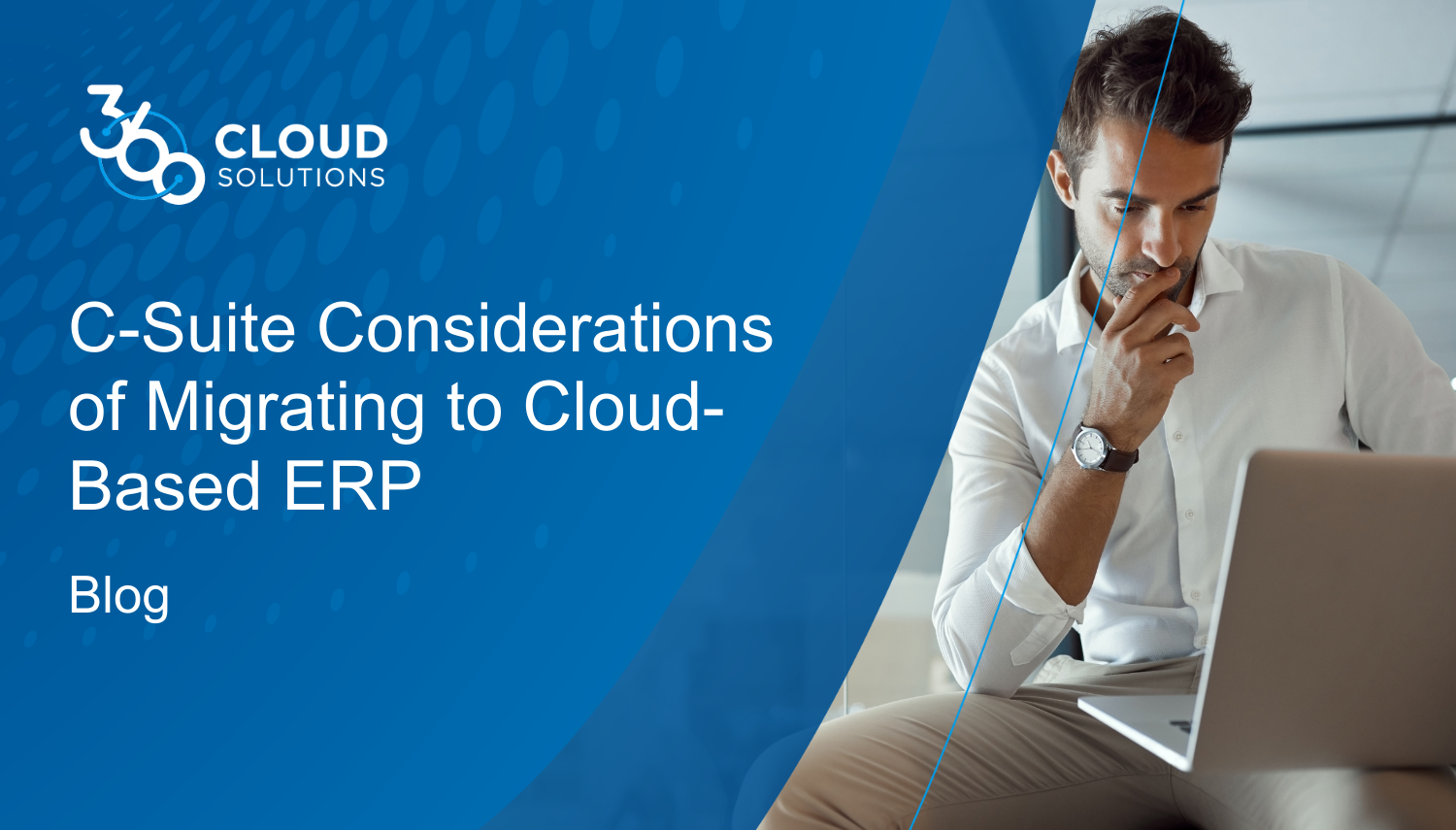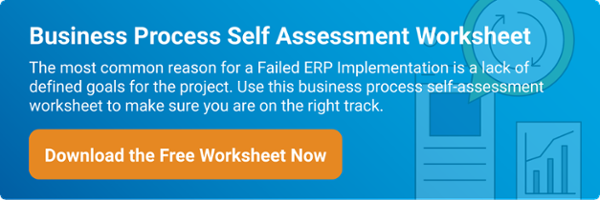
As the leaders of your organization, the C-Suite is required to stay on top of the latest innovations. Though software typically falls under IT, it affects the entire business. Here we take a look at C-Suite considerations of migrating to a cloud-based ERP system from a legacy on-premise solution.
Jump to any section
- Considerations for the CEO
- Considerations for the CIO/CTO
- Considerations for the CFO
- Considerations for the CMO
Considerations for the CEO
The Big Picture
One of the primary functions of the CEO is to maintain a macro perspective of their entire organization. The metaphor of the general sitting on his horse on the hillside overseeing a battle below is apt for many business environments. Fortunately, the modern CEO has a number of efficient tools to aid in managing the available resources, including one of the latest and proven to be greatest, cloud ERP software.
A study, sponsored by NetSuite and published by the Institute of Management Accountants, highlights a number of the challenges the CEO faces today. Facing an increasingly competitive environment, streamlining processes, and maximizing productivity are critical objectives in today’s workforce.
As the capabilities of information technology have migrated into each area of corporate operations, many disparate systems and information silos now exist in organizations causing the CEO much frustration as information is barely aligned. One function of cloud ERP is to achieve an increased degree of integration for those various systems and greater management visibility in a real-time environment. Creating an app platform using modern ERP software is proven to deliver a valuable ecosystem for all processes to run parallel.
Identifying the concerns and pain points
The IMA study attempted to identify the major business concerns of its members in the current operating, regulatory, and economic environments. It is no surprise that the responses hit the traditional “hot buttons” of management pain points:
- Transparency
- Communications
- Integration
- Streamlining
- Real-time responsiveness
While these responses show a wide diversity of concerns, they actually demonstrate a consistency of management requirements. It is also somewhat serendipitous that the capabilities of cloud ERP software are actually addressing and rectifying these issues in a number of ways.
Of additional significance to the CEO, is the priority placed on streamlining business processes while achieving increased productivity. These issues reflect the need to more effectively manage the explosion of IT capabilities that have accumulated over the past two decades, especially the Internet and cloud computing.
Integration as a requirement for visibility
Management requires accurate, detailed, current financial information to evaluate all aspects of company performance, from sales to customer service to human resources and it is the CEOs responsibility to find a well-suited ERP platform. Of course, having the data to monitor all aspects of financial performance, from cash flow to AR to AP underlies all of these information needs.
The real challenge in most enterprises is not just creating this information. Individual systems and departments create a wealth of data and detailed analyses using today’s modern applications. However, that challenge is found in the efficient and real-time integration of that information into actionable reports and insights for the C-Suite. Reports are great but if they are not reporting on real-time insights it does not do any good.
Settling for spreadsheets?
A shocking study from the IMA report produces one significant, almost counterintuitive, insight in the way such integration is currently achieved. They found that companies currently use:
- Spreadsheets in 68.3 percent of the companies
- Direct integration applications in 53.9 percent of the cases
- Other solutions for an additional 2.5 percent
The fact that the results from sophisticated applications are reduced to spreadsheets to make them usable points to the severity of today’s lack of effective system integration. This is reflected in the 76.9 percent of those surveyed lamenting the high level of manual effort required to achieve some semblance of meaningful, integrated results. In fact, such manual involvement is evidence of the lack of real-time information and lack of efficiency.
Improved and aligned financial systems are necessary for today’s workforce and providing your managers with the proper tools is essential. Don’t fall behind by using disparate business systems. The use of modern ERP systems will ensure only a single version of the truth and only a single customer record, moreover cutting down on additional checks and balances.
From a CEO standpoint, a cloud-based ERP software solution will also scale with business growth. After integration, these systems increase with firm size, allowing ease during rapid growth phases. These realities help explain why the NetSuite cloud ERP solution is the #1 cloud business management software suite on the market. The next step is deciding on a vendor who you can rely on for integration and who takes the time to communicate with you and learn your business processes to ensure
a perfect-fit solution.
Considerations for the CIO/CTO
In this globalizing economy, an organization’s CIO needs to be versatile and well attuned to the company’s business strategy. They are the organization’s technological leaders, seeking out new and innovative ways to leverage emerging technologies to improve company performance and stay ahead of the competition.
The debate between on-premise and cloud-based applications has come to an end, especially when it comes to new and expanding businesses. However, choosing the most cost-effective, flexible, and efficient cloud ERP system for your individual needs can be a challenge. No ERP system comes ready to use out of the box. Each business has its specific requirements, and as CIO, you need to evaluate two aspects:
- Compare systems against each other in terms of scalability, availability, SLAs, testing, and more.
- The vendor. You want to make sure you choose a vendor who takes the time to learn your business and communicates with you throughout the integration. Don’t fall into the trap of using the first vendor you find, make the most of your investment.
Consider the features to look for in a cloud ERP platform:
- Customizations: Your business is unique, and even the most industrial, fully loaded ERP software solutions cannot work seamlessly for any company out of the box and it shouldn’t. Therefore, you need a platform with superior customization possibilities that will enable all of your resources to improve efficiency.
- Integrations: A cloud ERP solution must be able to support a diversity of integration options for vertical industry applications. The vendor must support various integration options from flat file import/export to dynamic web services and published APIs.
- Upgrades: A key benefit of SaaS delivery is that automatic vendor upgrades are applied and designed to minimize business disruption. If you are familiar with how on-premise software upgrades work, you will be pleasantly surprised when upgrades are due on your cloud-based software. However, it is important to compare upgrade processes and adaptions between cloud ERP systems, as not all may be as seamless as NetSuite upgrades are.
- Security: Business security is critical for any CIO as you are your enterprise data “gatekeeper.” Verify the strength and flexibility of various cloud ERP security systems you are considering. For instance, does a specific platform support single sign-on and integration with operating system directories?
- Availability: A system outage can spell financial disaster, particularly when it happens to customer-facing e-commerce applications. Discover the various service level agreements, compensation amounts for outages, upgrade schedules, and planned downtimes behind a considered cloud ERP system. (Did you know NetSuite has a guaranteed uptime of 99.5%?)
- Ecosystem: Verify that your third-party applications currently being used can integrate with a considered cloud ERP solution, and ensure that the vendor has partnerships with other cloud application solutions such as document management, budgeting, single-sign-on, and more so that you have options for add-ons.
- Innovation: Choosing an ERP solution is a long-term commitment. As a CIO it is your responsibility to find a vendor committed to ongoing innovation, allowing you to stay a few steps ahead of the competition.
A proven cloud ERP solution to effectively improve business performance for both emerging and growing businesses is NetSuite. NetSuite has engineered an effective and efficient system designed to work in tandem with all types of businesses to streamline various processes to improve ROI. As a CIO, you would likely adopt a platform with superior extensibility that enables your staff to leverage their skills. After the decision of going with NetSuite, it is time to look for a NetSuite provider to make your business dreams a reality.
Consider how the following features work with your business’ unique processes:
- Development Environment: As you have probably heard before, no solution is a one-size, fits all. However, with NetSuite vs. an on-premise ERP, the complexity of incorporating customized code vanishes, and upgrade releases are no effort at all. Upgrades are automatic with cloud-based ERP software and any custom development will be carried over to the latest version. Version lock is not apparent.
- Integrations: By using a cloud-based ERP system, NetSuite allows data to be easily and readily accessible wherever and however you need it and within a single system. What this means to you is that data can be exposed through scripting and web services and can both be swiftly imported and exported. Leverage NetSuite’s flat-file import tool to easily load budgets from Excel, and use the values throughout the procurement process to calculate encumbrance and expense amounts by account. This encumbrance data can then be published to budgeting tools like Adaptive Insights through web services, no longer will you need to use excel spreadsheets. (Note: Adaptive Planning is a collaborative, powerful yet simple cloud-based tool for revenue planning, budgeting forecasting, and sales planning in real-time.)
- Upgrades: Normally cloud ERP software only has a few large system upgrades per year, allowing for users to access the latest and greatest version of the ERP software. As a CIO it is up to you to take advantage of your sandbox environment so that you can test and configure and ensure that your organization is ready for the upgrade.
- Security: It is essential that you get assurance that the ERP platform you choose is physically secure. It is not uncommon for CIOs to demand a security audit report from the cloud vendor. Be sure to confirm the security measures used to eliminate risk at the data center, data breaches, and security processes. Paying attention to security standards such as SSAE 16 (SOC1), PCI-DSS, and US-EU Safe Harbor framework and make sure the vendor has met these. The vendor you choose should most definitely have met security standards according to the National Institute of Standards and Technology (NIST) and ISO 27000 series of standards for reference.
- Reporting: Use NetSuite cloud ERP system to deliver reporting capabilities unique to your business and industry. This
includes encumbrance control, special report customization, easy-touse external reporting tools, and dashboard charts and data lists. Of the most popular IT requests is the customization of data reports. The platform that you select should support extensive report configuration including data columns, data filters and grouping levels to that ensure true, useful data can be easily obtained. - Streamline Business Processes: The NetSuite cloud ERP system provides a full workflow automation environment custom for your business. You can use this to easily manage your management approval process. For example: Whenever a PO gets approved, it means that funds are committed to being expensed. With a cloud ERP system, this approval step triggers code to manage the actual purchase order amount versus budget estimates. All activities are recorded, providing an audit trail of who completed what, when.
A modern CIO should be using these useful tools to free up time and effort spent on trying to support a multitude of systems.
Selecting a cloud ERP provider can be challenging but knowing what to look for will make it a lot simpler process. As a CIO it is important to evaluate not only the solution but also the solution provider to implement your solution. Evaluate vendors until you find one that takes an agile approach and communicates with you to understand your business processes, this will
ensure that you get the most of your investment. Eliminate the stress of unaligned processes by choosing an ERP solution that will scale as your business enters rapid growth phases and a vendor who will take time in getting to know your specific needs and goals for your ERP solution.
Considerations for the CFO
The role of financial leadership is changing in many organizations. Now more than ever, financial leaders are being asked not only to calculate and provide financial information but also to provide strategic input. Financial leaders are working with all business functions, from manufacturing to supply chain to marketing. The changing role of financial leaders has also increased the need for cloud ERP solutions, which can provide the information and insight needed to make informed strategic decisions.
Read Now: The CFO’s Guide to Cloud ERP Solutions
Senior financial roles are changing
In 2013, the Institute of Management Accountants conducted a study on senior financial executives and the roles they play in many businesses. Researchers found that the role of many CFOs is shifting away from administrative and transactional work and towards more strategic input that adds value to the business. Participants in the study came from a diverse set
of industries. Manufacturing led the way with more than 40 percent of respondents. Other industries with sizable representation included services, wholesale/distribution, finance, construction and contracting retail/e-commerce, healthcare, and technology.
The same is also true of controllers, many of whom are handling both CFO and controller duties. In fact, 31 percent of controllers who participated in the study said that their duties include those that would normally be performed by a CFO. Another seven percent said that their company had no need for a CFO. This kind of controller/CFO overlap was most prevalent at companies that had less than 200 employees.
Regardless of whether the title is CFO, controller, or both, the study clearly showed that the finance team is now more likely required to provide strategic advice for the overall business functions. Nearly 80 percent of survey participants said that their day-to-day activities now involve more strategic and value-added work rather than simply aggregating and calculating financial results.
Financial leaders were also found to work with nearly every department in a company. Survey respondents from the Institute of Management Accountants study said they work with some departments more than others, with IT, compliance, sales, and HR is the most frequently mentioned. However, more than 80 percent of the surveyed financial executives said they work with other functions like marketing and supply chain.
Increased need for strategy brings an increased need for cloud ERP
A company may have a need for strategy input from the CFO’s office, but that input requires a cloud ERP platform that provides deep insight into the business’s operations. According to a recent whitepaper from cloud ERP provider NetSuite “The Money Story,” many businesses are using monolithic ERP solutions that aren’t designed to meet today’s needs. Rather, they should be using cloud-based ERP systems for real-time, anywhere, anytime access to important business data.
Russ Banham came up with “the seven deadly sins of ERP” and how those sins can be resolved by using a cloud ERP solution that offers a 360-degree view of the business. He says that without a cloud ERP solution, CFOs and controllers are akin to financial executives “from yesteryear, crunching the numbers of the previous quarter in their green eyeshades.” One of Banham’s deadly sins is the dreaded “hairball,” a complex mass of systems that are so intertwined that it’s impossible to get a clear view of the enterprise. Many CFOs are using really innovative solutions yet they are unaligned. Eliminate “the hairball” by integrating all applications onto a single platform and seeing the benefits of organizational transparency.
Another deadly sin of ERP is waiting for real-time information. Without the use of a modern ERP system real-time data is impossible to truly obtain, making it impossible to make timely decisions. Real-time data is a necessity for today’s CFOs and controllers. Using old-fashion, on-premise ERP solutions have updates that do more damage than good. It is not the company’s IT team that is at fault, it is the fault of the company using a legacy system. Often times when each legacy ERP is upgraded, it slows down the business engine and actually slows down business productivity.
With issues like these, it is impossible to make sense of the financial status of any company or to suggest accurate advice as many CFO’s and controllers are asked to do in the modern-day. What is the solution for the CFO? A cloud ERP that provides real-time insight into the enterprise and facilitates strategic thinking and discussion. Solutions such as NetSuite’s cloud ERP are designed to meet the new strategic demands of the CFO and controller office, allowing them to add value and have a real impact on their company’s business outcomes. A critical success factor in today’s workforce.
Considerations for the CMO
The rapidly evolving world of digital marketing creates an ambivalent reaction for many Chief Marketing Officers. While the Internet, social media and other online tools provide new and exciting ways to reach out to customers and prospects, they also raise the expectations of those players and demand new levels of responsiveness. Delivering on these needs requires a level of capabilities many CMOs struggles to access.
Dead information or actionable data?
If one adds the growing importance of both big data and CRM, the demand for real-time, usable information becomes crucial. It is easy to understand why the CMO is one more C-Level executive intimately concerned about company IT structures and such current innovations as cloud ERP software.
The traditional growth in information technology structures within companies has created a number of situations where efficient and state-of-the-art systems produce terabytes of valuable information. Unfortunately, much of that potentially useful data remains untapped, separated from other divisions and departments. Even many small and medium-sized businesses find
themselves bogged down with this information overload.
Meeting the CMO’s information needs
For today’s CMO, information that is not timely and relevant is worse than no information at all. Achieving transparency across sales, marketing, product development, customer service, and finance is essential to the CMO function. This is the only way to proactively evaluate and manage the real-time performance of individual campaigns, products, and overall marketing initiatives.
Recognizing this vital need for timely data, a number of major firms, such as NetSuite, provide useful cloud-based services.
However, it takes a cloud ERP solution to deliver the top-level integration of information sources that the CMO requires on a daily basis. In a recent study for the Institute of Management Accountants sponsored by NetSuite, this issue of real-time visibility was discussed. Of more than 1,500 respondents to the survey, the effective integration of information systems was raised as a primary concern. While these were primarily executives concerned with the accounting function, they honed in on the issues that are the CMOs concern, including:
- Revenue tracking and recognition
- Salesforce management, accountability, and automation
- Support functions
The days of waiting for monthly and quarterly sales reports to adjust marketing strategies and sales activities are eliminated with the use of cloud-based ERP software. In this age of A/B testing and instant market responses, the ability to proactively manage real-time sales reports by individual markets and salespeople is the new standard of performance.
The CMO is not the only C-Level function feeling the pressure of compressed response times. The management reporting cycle, as noted in the IMA report, continues to shrink and both marketing and compliance issues drive the demand for rapid consolidation of internal reports.
The new power of cloud ERP
Nothing in this discussion is new as a concern to the occupants of the executive suite or the field marketing and sales teams. For more than 30 years the concept of Enterprise Resource Planning has provided a start to solving the problem. However, what is new is twofold. First is a sense of urgency. The C-level management transparency made possible with real-time, accurate information is no longer a competitive advantage; it is now an operational necessity.
Secondly, cloud ERP solutions open the door to new possibilities for companies of all sizes, from the smallest to the largest. As an affordable, scalable resource, cloud ERP capabilities open many previously closed doors. For example, even a mid-sized CMO can propose and use big data applications (such as loyalty programs) previously available to only the largest of the Fortune 500.
For the CMO seeking to keep a finger on the forefront of marketing and sales, cloud ERP is an essential platform. Gain real-time internal stats so that you can easily and proactively change or create marketing campaigns to increase your bottom line.
As tools become more powerful, technology more advanced, business interactions faster, and demands more immediate, it should come as no surprise to the savvy executive that using the best technology is becoming increasingly more important in securing your place as a top-level competitor. Your business management software can mean the difference between unparalleled success and abject failure. It pays, then, to invest in quality software solutions to improve business processes and accelerate cash-to-order.
It’s easy to see why nearly 4 out of 5 small businesses operate using cloud-based software such as NetSuite. Agile, forward-thinking companies are quickly adopting technology that’s sure to dominate the future of business management software. Competitors who drag their feet will be left to suffer the consequences in the market as they fall behind in agility, information control, and general performance.




